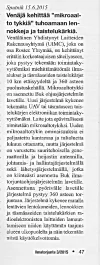OldSkool
Kapteeni
Kaappaustyökaluista uutinen:
Brittiläinen turvallisuusalan yhtiö Selex ES esitteli tiistaina Lontoossa sähkömagneettista kilpeä, jolla voi suojautua lennokeilla tehtäviä iskuja vastaan, kertoo Sputnik.
Kun lennokki lentää Falcon Shield -järjestelmän kantaman sisään, se lakkaa tottelemasta ohjaajaansa ja lennätetään turvallisesti takaisin maan kamaralle ilman, että suojeltavana olevalle kohteelle aiheutuu vaaraa.
Tekniikkansa yksityiskohtia ei Selex ES halunnut paljastaa.


